On-Road Measurements and Modelling of Disc Brake Temperatures and Brake Wear Particle Number Emissions on a Heavy-Duty Tractor Trailer
Abstract
1. Introduction
2. Measurement Setup
2.1. Description of Dataset
2.2. Reduced Pump Speeds
3. Data Analysis Methodology
3.1. Preprocessing of the Data
- At every second, the mean-centred 5 s rolling average acceleration was negative;
- At every second, the mean-centred 3 s rolling average disc temperature was increasing;
- The overall disc temperature increase between the start and the end of the event was at least 1 ;
- The duration of the event was at least 3 s.
3.2. Braking Event Selection Cuts
3.3. Cooling Event Selection Cuts
4. Temperature and Particle Number at a Trip Level
5. Modelling Disc Brake Heating and Cooling at the Brake Event Level
5.1. Disc Brake Heating
5.2. Disc Brake Cooling
6. Modelling Particle Number Under Braking
7. Conclusions
- When distinguishing three different road types ‘Urban’, ‘Rural’ and ‘Motorway’, the highest average brake disc temperatures and the most braking actions per kilometre were observed on urban roads. Conversely, the lowest average temperatures and the lowest number of braking events per kilometre were observed on the motorway.
- In line with the first result, the highest particle number emissions per kilometre per brake of were seen on urban roads. These were followed by rural roads with particles per kilometre per brake. Lastly, on the motorway, the lowest particle number emissions of particles per kilometre per brake were observed.
- Rigorous filtering of the data was necessary to be able to establish the expected correlations from physical principles. A possible source of noise was vibrations introduced during the on-road measurements.
- A relationship was established between the braking work applied on the braking disc during the braking action and the PN emissions of the braking action.
- When modelling the heating of the (surface) temperature of the brake disc, a dependence on the braking work was observed. The results were improved if a further dependence on the initial temperature of the brake disc at the start of the braking event was introduced so that the modelled temperatures were allowed to rise more quickly. This may have been due to the fact that this term encoded the ‘historic braking actions’ in some sense, which added energy to the bulk, allowing temperatures to rise more quickly during a new braking action.
- When modelling the cooling of the disc’s (surface) temperature, a non-linear dependence on the temperature difference between the brake disc temperature and the ambient air temperature was found. No clear evidence was found in the data for a dependence on the vehicle velocity.
Author Contributions
Funding
Institutional Review Board Statement
Informed Consent Statement
Data Availability Statement
Acknowledgments
Conflicts of Interest
References
- Frateur, T. Health Effects of Brake Wear Particle Emissions. Informal Document GRPE-90-30. 2024. Available online: https://unece.org/sites/default/files/2024-01/GRPE-90-30e.pdf (accessed on 1 May 2025).
- Wahid, S.M. Automotive brake wear: A review. Environ. Sci. Pollut. Res. 2018, 25, 174–180. [Google Scholar] [CrossRef] [PubMed]
- Peters, A.; Wichmann, H.E.; Tuch, T.; Heinrich, J.; Heyder, J. Respiratory effects are associated with the number of ultrafine particles. Am. J. Respir. Crit. Care Med. 1997, 155, 1376–1383. [Google Scholar] [CrossRef] [PubMed]
- Amato, F.; Cassee, F.R.; Van Der Gon, H.A.D.; Gehrig, R.; Gustafsson, M.; Hafner, W.; Harrison, R.M.; Jozwicka, M.; Kelly, F.J.; Moreno, T.; et al. Urban air quality: The challenge of traffic non-exhaust emissions. J. Hazard. Mater. 2014, 275, 31–36. [Google Scholar] [CrossRef] [PubMed]
- Grigoratos, T.; Martini, G. Brake wear particle emissions: A review. Environ. Sci. Pollut. Res. 2015, 22, 2491–2504. [Google Scholar] [CrossRef] [PubMed]
- Akhbarizadeh, R.; Dobaradaran, S.; Torkmahalleh, M.A.; Saeedi, R.; Aibaghi, R.; Ghasemi, F.F. Suspended fine particulate matter (PM2. 5), microplastics (MPs), and polycyclic aromatic hydrocarbons (PAHs) in air: Their possible relationships and health implications. Environ. Res. 2021, 192, 110339. [Google Scholar] [CrossRef] [PubMed]
- Sridharan, S.; Kumar, M.; Singh, L.; Bolan, N.S.; Saha, M. Microplastics as an emerging source of particulate air pollution: A critical review. J. Hazard. Mater. 2021, 418, 126245. [Google Scholar] [CrossRef] [PubMed]
- Shaddick, G.; Thomas, M.L.; Mudu, P.; Ruggeri, G.; Gumy, S. Half the world’s population are exposed to increasing air pollution. NPJ Clim. Atmos. Sci. 2020, 3, 23. [Google Scholar] [CrossRef]
- West, J.J.; Cohen, A.; Dentener, F.; Brunekreef, B.; Zhu, T.; Armstrong, B.; Bell, M.L.; Brauer, M.; Carmichael, G.; Costa, D.L.; et al. What we breathe impacts our health: Improving understanding of the link between air pollution and health. Environ. Sci. Technol. 2016, 50, 4895–4904. [Google Scholar] [CrossRef] [PubMed]
- Costa, L.G.; Cole, T.B.; Coburn, J.; Chang, Y.C.; Dao, K.; Roqué, P.J. Neurotoxicity of traffic-related air pollution. Neurotoxicology 2017, 59, 133–139. [Google Scholar] [CrossRef] [PubMed]
- Von Schneidemesser, E.; Monks, P.S.; Allan, J.D.; Bruhwiler, L.; Forster, P.; Fowler, D.; Lauer, A.; Morgan, W.T.; Paasonen, P.; Righi, M.; et al. Chemistry and the linkages between air quality and climate change. Chem. Rev. 2015, 115, 3856–3897. [Google Scholar] [CrossRef] [PubMed]
- Fiore, A.M.; Naik, V.; Leibensperger, E.M. Air quality and climate connections. J. Air Waste Manag. Assoc. 2015, 65, 645–685. [Google Scholar] [CrossRef] [PubMed]
- Baensch-Baltruschat, B.; Kocher, B.; Stock, F.; Reifferscheid, G. Tyre and road wear particles (TRWP)—A review of generation, properties, emissions, human health risk, ecotoxicity, and fate in the environment. Sci. Total Environ. 2020, 733, 137823. [Google Scholar] [CrossRef] [PubMed]
- Denier van der Gon, H.A.; Gerlofs-Nijland, M.E.; Gehrig, R.; Gustafsson, M.; Janssen, N.; Harrison, R.M.; Hulskotte, J.; Johansson, C.; Jozwicka, M.; Keuken, M.; et al. The policy relevance of wear emissions from road transport, now and in the future—An international workshop report and consensus statement. J. Air Waste Manag. Assoc. 2013, 63, 136–149. [Google Scholar] [CrossRef] [PubMed]
- Yin, J.; Xu, Z.; Wei, W.; Jia, Z.; Fang, T.; Jiang, Z.; Cao, Z.; Wu, L.; Wei, N.; Men, Z.; et al. Laboratory measurement and machine learning-based analysis of driving factors for brake wear particle emissions from light-duty electric vehicles and heavy-duty vehicles. J. Hazard. Mater. 2025, 488, 137433. [Google Scholar] [CrossRef] [PubMed]
- Koupal, J.; DenBleyker, A.; Kishan, S.; Vedula, R.; Agudelo, C.; Eastern Research Group, Inc.; LINK Engineering Company; California, Department of Transportation, Division of Research, Innovation, and System Information. Brake Wear Particulate Matter Emissions Modeling; Technical Report; California Department of Transportation, Division of Research and Innovation: Sacramento, CA, USA, 2021.
- United Nations. Proposal for a New Amendment to UN Global Technical Regulation No. 24 (Laboratory Measurement of Brake Emissions for LightDuty Vehicles). 2024. pp. 1–174. Available online: https://unece.org/sites/default/files/2024-11/ECE-TRANS-WP29-GRPE-2024-04e.pdf (accessed on 1 May 2025).
- European Union. Regulation (EU) 2024/1257 of the European Parliament and of the Council of 24 April 2024 on Type-approval of Motor Vehicles and Engines and of Systems, Components and Separate Technical Units Intended for such Vehicles, with Respect to their Emissions and Battery Durability (Euro 7), Amending Regulation (EU) 2018/858 of the European Parliament and of the Council and Repealing Regulations (EC) No 715/2007 and (EC) No 595/2009 of the European Parliament and of the Council, Commission Regulation (EU) No 582/2011, Commission Regulation (EU) 2017/1151, Commission Regulation (EU) 2017/2400 and Commission Implementing Regulation (EU) 2022/1362. Available online: http://data.europa.eu/eli/reg/2024/1257/oj (accessed on 7 May 2025).
- Gijseman, R.; Vroom, Q.; Steinmetz, M.F.; Boukallouht, Z.; Kranendonk, M.; Dimaratos, A.; Saltas, E.; Tsakonas, G.; Samaras, Z.; Mamarikas, S.; et al. PP012101 Pilot Project—Feasibility Study on Reduction of Traffic-Related Particulate Emissions by Means of Vehicle-Mounted Fine Dust Filtration. Technical report. TNO, Horiba, KTH, LAT and e:misia, 2025. Funded by the European Union. Available online: https://resolver.tno.nl/uuid:32e22274-a482-4668-9b8d-d23cd078b908 (accessed on 1 May 2025).
- Hagino, H.; Oyama, M.; Sasaki, S. Laboratory testing of airborne brake wear particle emissions using a dynamometer system under urban city driving cycles. Atmos. Environ. 2016, 131, 269–278. [Google Scholar] [CrossRef]
- Lee, E.S.; Sahay, K.; O’Neil, E.; Biswas, S.; Dzhema, I.; Huang, S.M.; Lin, P.; Chang, M.C.O.; Huai, T. Tracer-Gas-Integrated Measurements of Brake-Wear Particulate Matter Emissions from Heavy-Duty Vehicles. Environ. Sci. Technol. 2023, 57, 15968–15978. [Google Scholar] [CrossRef] [PubMed]
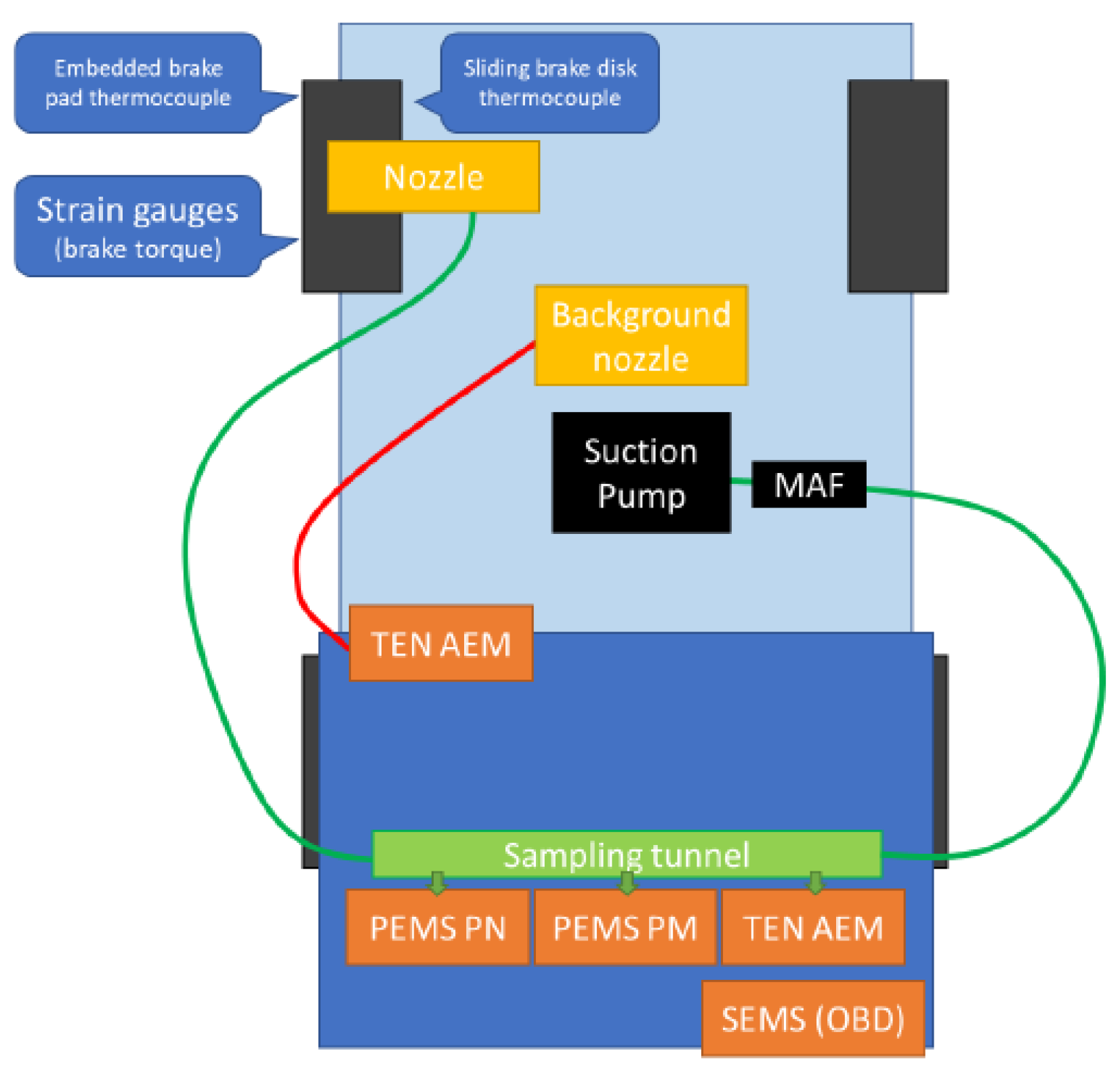
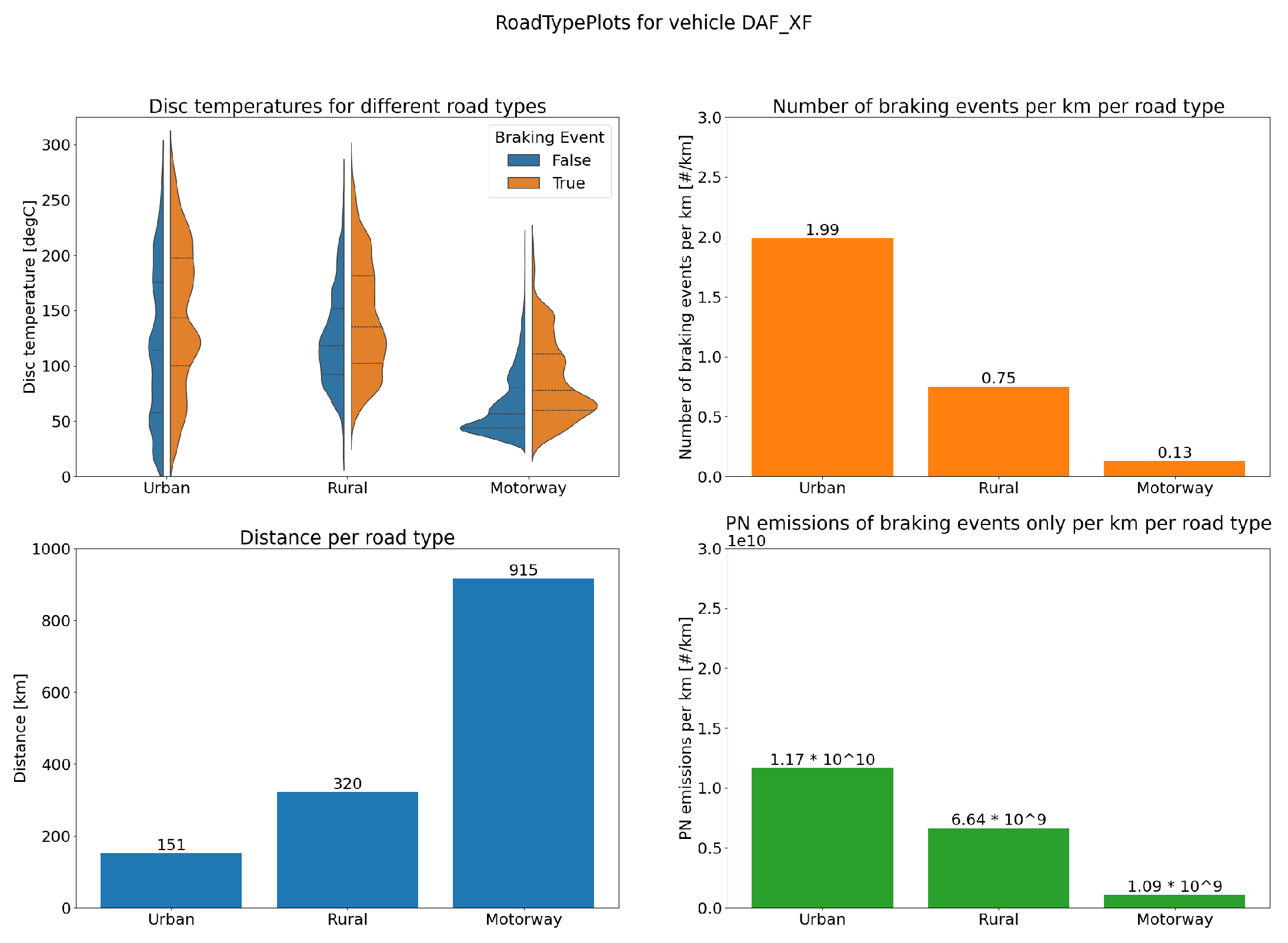
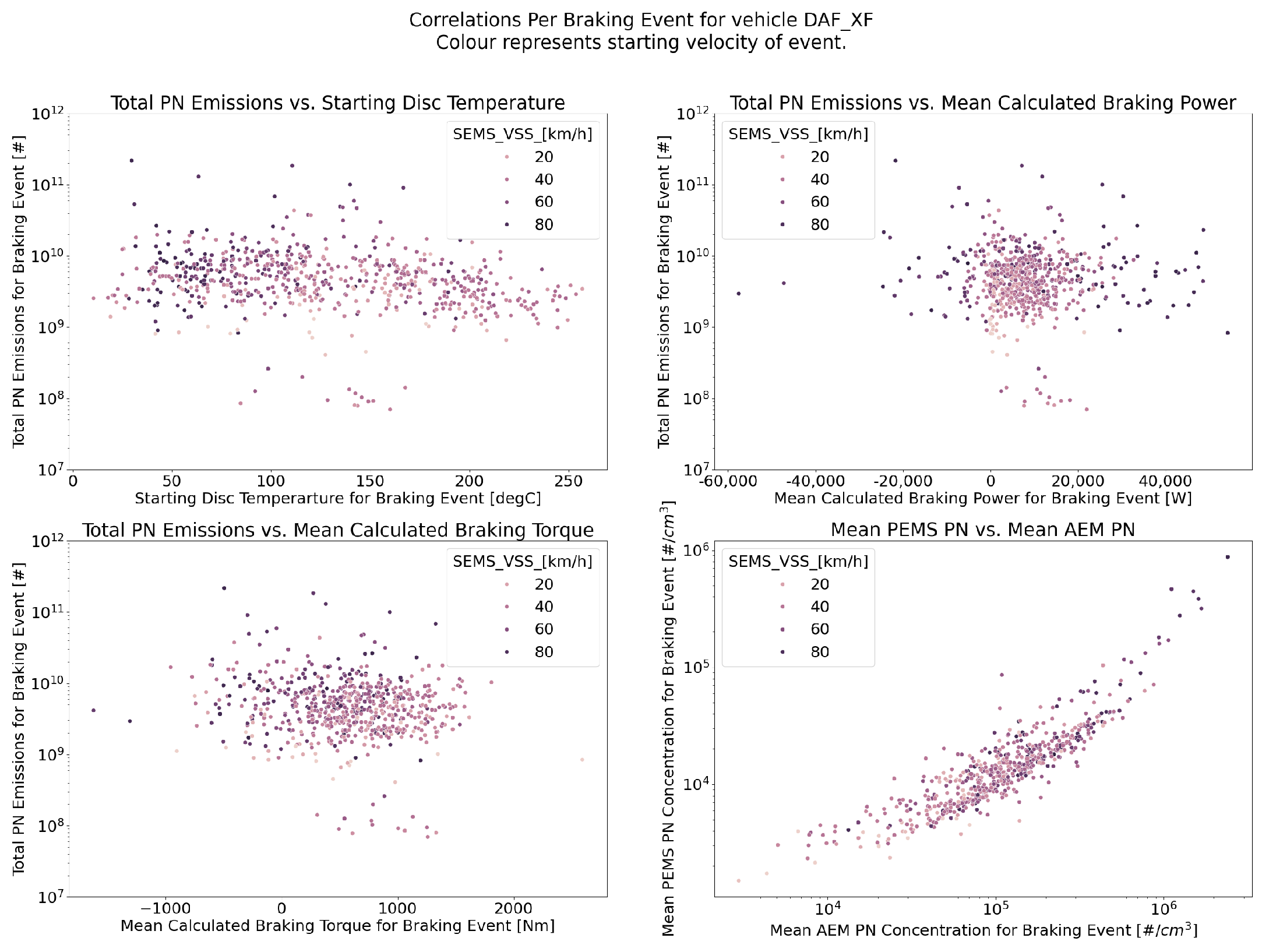
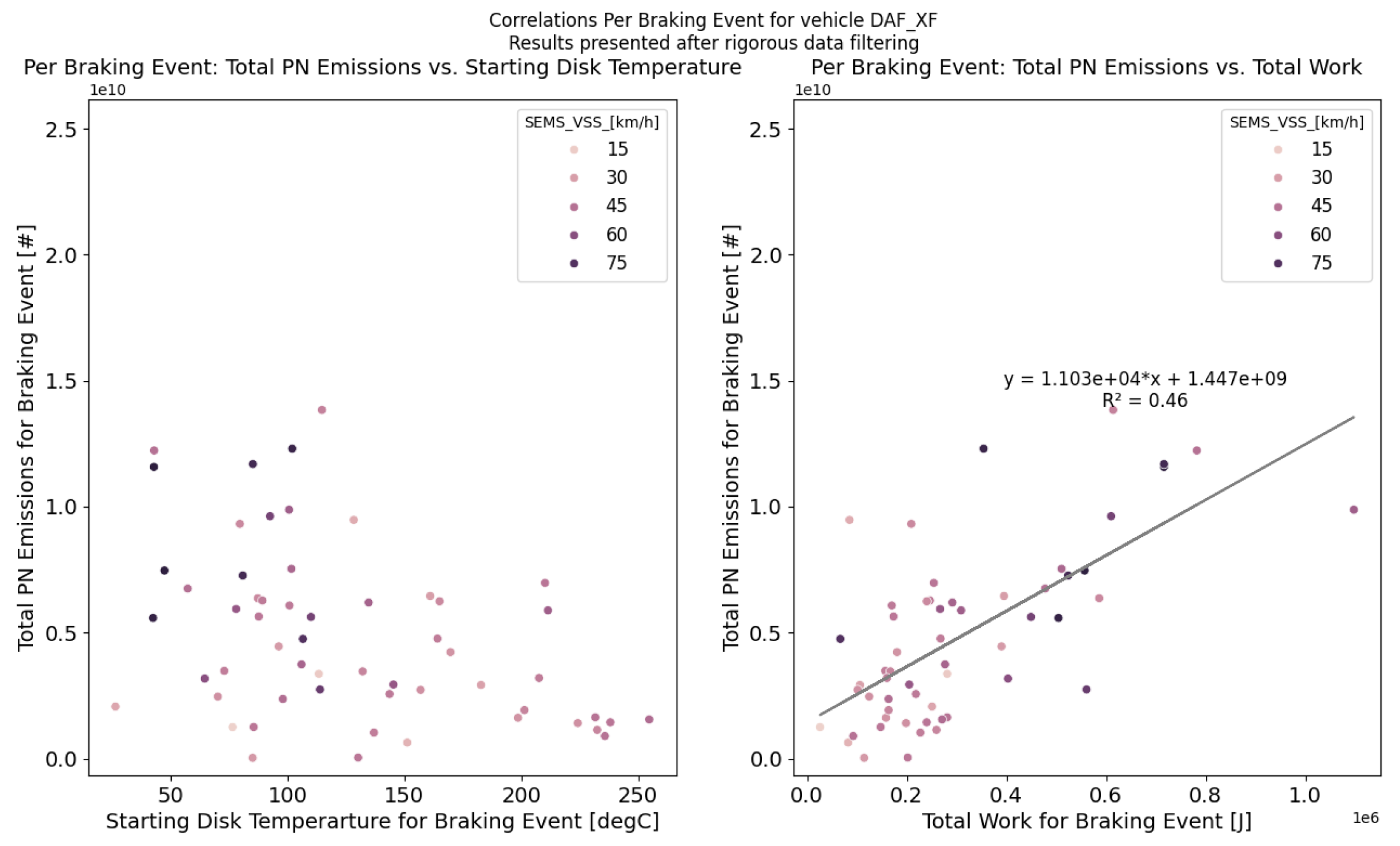
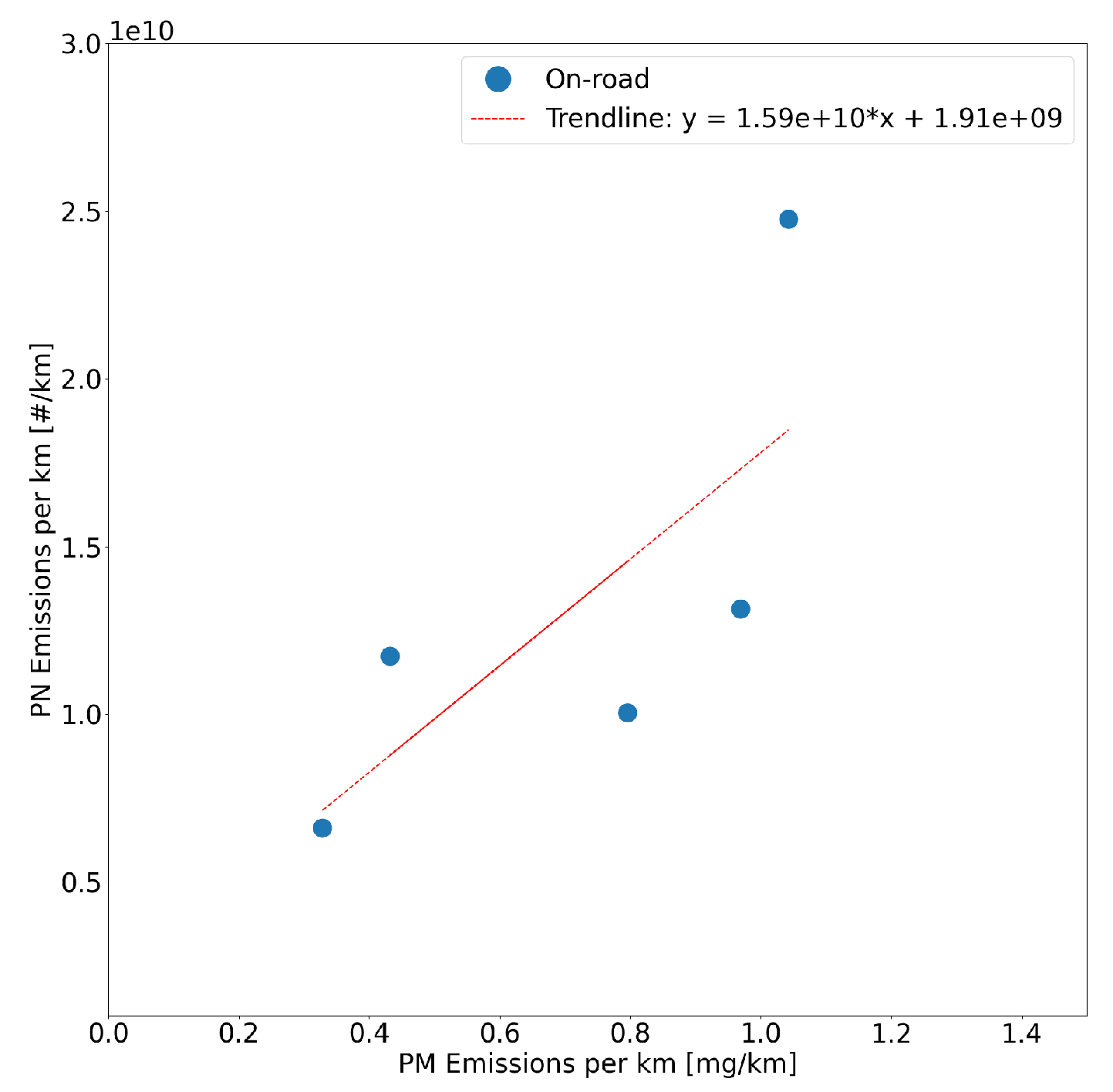
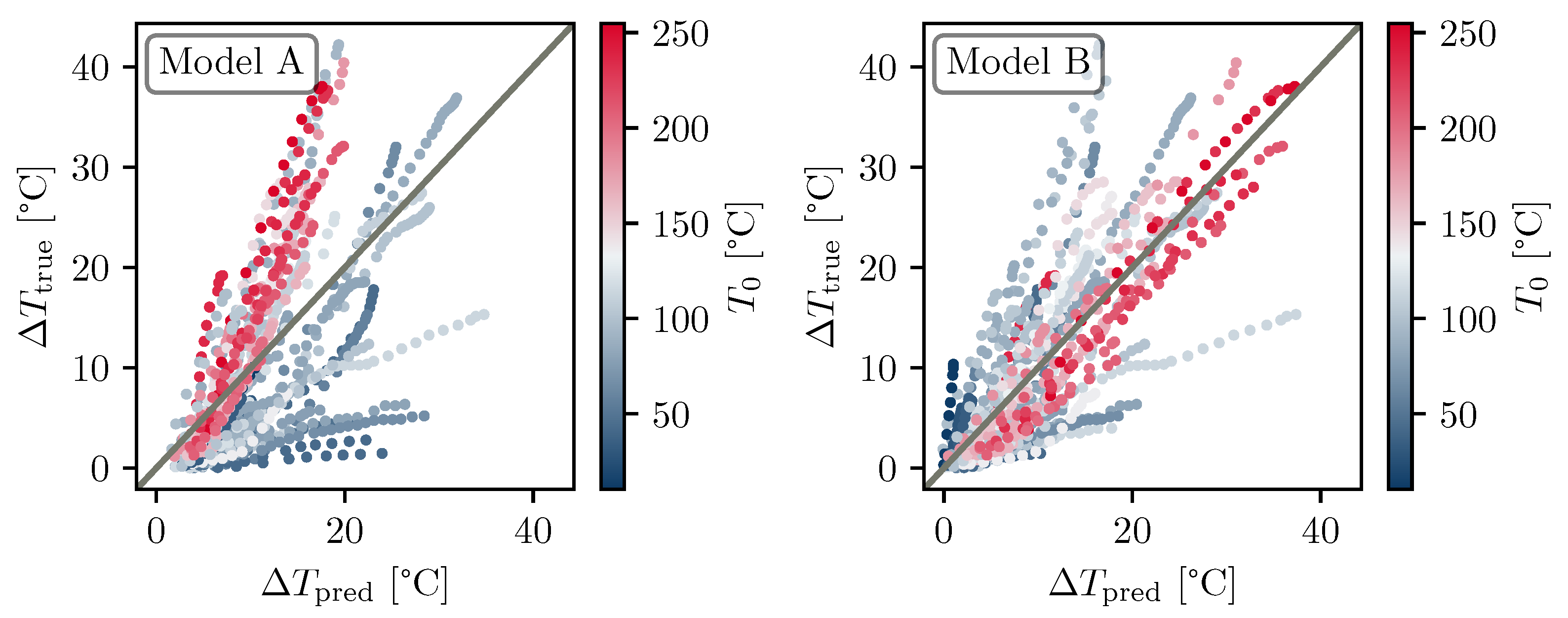
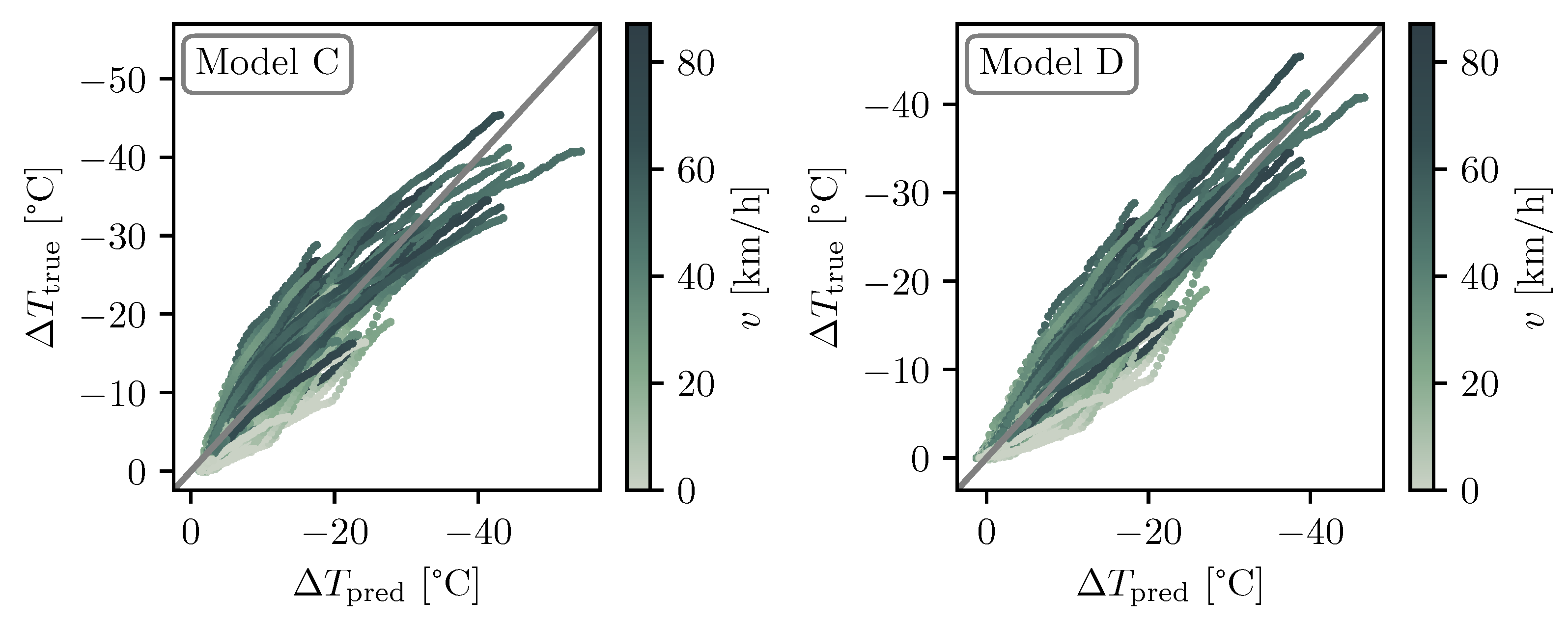
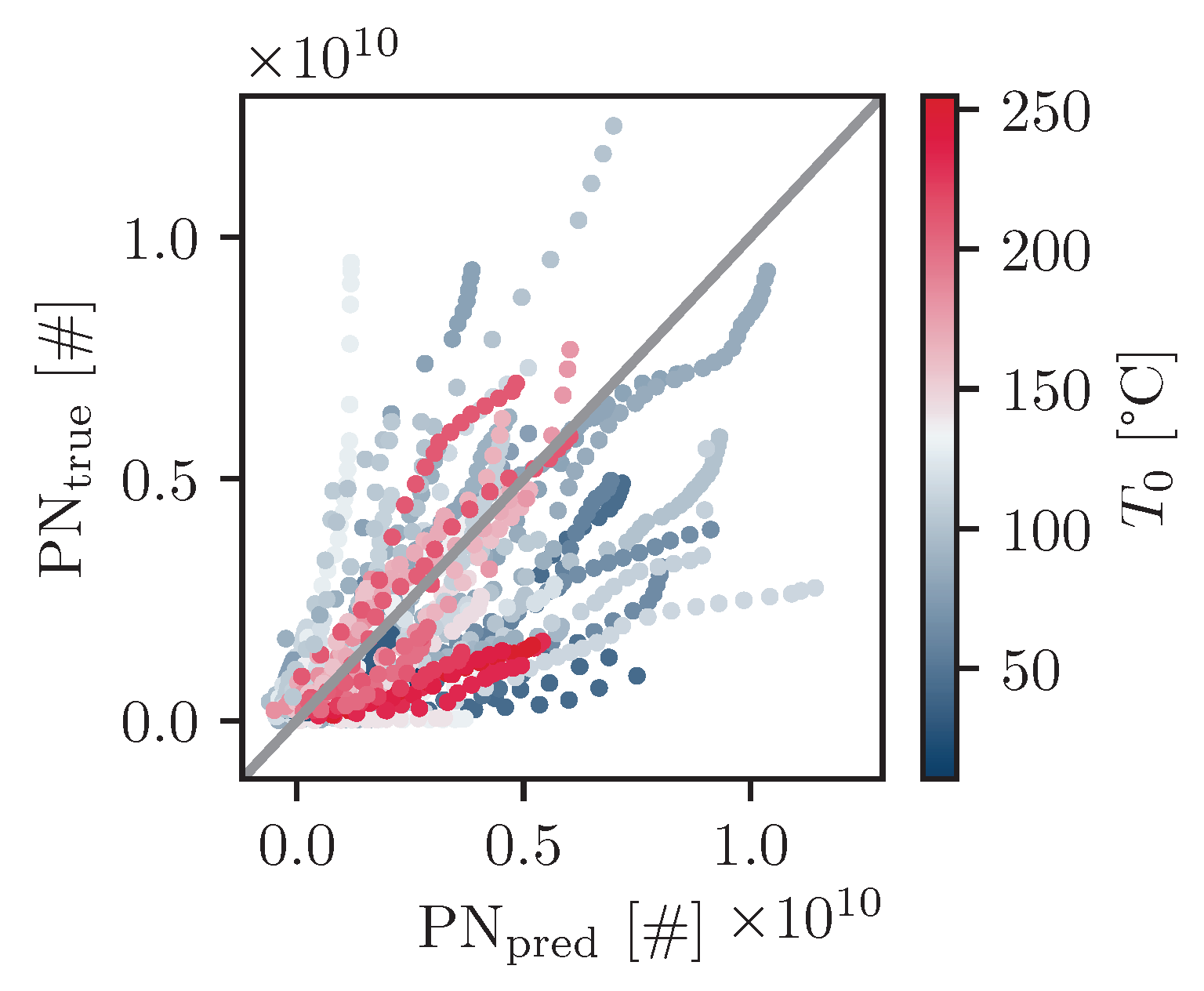
| Trip | Distance [km] | PM Emissions [mg/km] | PN Emissions [#/km] |
|---|---|---|---|
| Trip A | 406.29 | 0.33 | |
| Trip B | 196.63 | 0.80 | |
| Trip C | 122.21 | 0.43 | |
| Trip D | 114.09 | 0.97 | |
| Trip E | 135.87 | 1.04 |
| Best-Fit Parameters | |||
|---|---|---|---|
| Model | [°CJ−1] | [°C] | |
| Model A | - | ||
| Model B | |||
| Model | |||
|---|---|---|---|
| Model A | 51.8 | 5.4 | 1.8 |
| Model B | 33.1 | 4.1 | 0.9 |
| Best-Fit Parameters | |||
|---|---|---|---|
| Model | [°CJ−1] | [°C] | |
| Model C | - | ||
| Model D | |||
| Model | |||
|---|---|---|---|
| Model C | 8.4 | 2.2 | 0.8 |
| Model D | 7.3 | 2.0 | 0.4 |
| [#/J] | [#] |
|---|---|
| 3.3 |
Disclaimer/Publisher’s Note: The statements, opinions and data contained in all publications are solely those of the individual author(s) and contributor(s) and not of MDPI and/or the editor(s). MDPI and/or the editor(s) disclaim responsibility for any injury to people or property resulting from any ideas, methods, instructions or products referred to in the content. |
© 2025 by the authors. Licensee MDPI, Basel, Switzerland. This article is an open access article distributed under the terms and conditions of the Creative Commons Attribution (CC BY) license (https://creativecommons.org/licenses/by/4.0/).
Share and Cite
Steinmetz, M.F.A.; Aschersleben, J.; Panagiotidou, A. On-Road Measurements and Modelling of Disc Brake Temperatures and Brake Wear Particle Number Emissions on a Heavy-Duty Tractor Trailer. Atmosphere 2025, 16, 561. https://doi.org/10.3390/atmos16050561
Steinmetz MFA, Aschersleben J, Panagiotidou A. On-Road Measurements and Modelling of Disc Brake Temperatures and Brake Wear Particle Number Emissions on a Heavy-Duty Tractor Trailer. Atmosphere. 2025; 16(5):561. https://doi.org/10.3390/atmos16050561
Chicago/Turabian StyleSteinmetz, Misja Frederik Alban, Jann Aschersleben, and Aspasia Panagiotidou. 2025. "On-Road Measurements and Modelling of Disc Brake Temperatures and Brake Wear Particle Number Emissions on a Heavy-Duty Tractor Trailer" Atmosphere 16, no. 5: 561. https://doi.org/10.3390/atmos16050561
APA StyleSteinmetz, M. F. A., Aschersleben, J., & Panagiotidou, A. (2025). On-Road Measurements and Modelling of Disc Brake Temperatures and Brake Wear Particle Number Emissions on a Heavy-Duty Tractor Trailer. Atmosphere, 16(5), 561. https://doi.org/10.3390/atmos16050561






